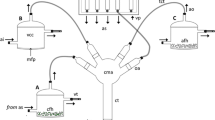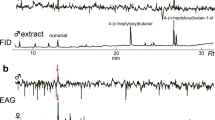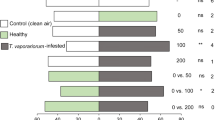Abstract
Volatiles released from corn seedlings on which beet armyworm larvae were feeding were attractive to females of the parasitoid,Cotesia marginiventris (Cresson), in flight tunnel bioassays. Analyses of the collected volatiles revealed the consistent presence of 11 compounds in significant amounts. They were: (Z)-3-hexenal, (E)-2-hexenal, (Z)-3-hexen-1-ol, (Z)- 3-hexen-1-yl acetate, linalool, (3E)-4,8-dimethyl-1,3,7-nonatriene, indole, α-trans-bergamotene, (E)-β-farnesene, (E)-nerolidol, and (3E,7E)-4,8,12-trimethyl-1, 3,7,ll-tridecatetraene. A synthetic blend of all 11 compounds was slightly less attractive to parasitoid females than an equivalent natural blend. However, preflight experience with the synthetic blend instead of experience with a regular plant-host complex significantly improved the response to the synthetic blend. Our results suggest thatC. marginiventris females, in their search for hosts, use a blend of airborne semiochemicals emitted by plants on which their hosts feed. The response to a particular odor blend dramatically increases after a parasitoid experiences it in association with contacting host by-products.
Similar content being viewed by others
References
Alphen, J.J.M. Van, andVet, L.E.M. 1986. An evolutionary approach to host finding and selection, pp. 23–61,in J.K. Waage, and D.J. Greathead (eds.). Insect Parasitoids. Academic Press, London.
Bestmann, H.-J., Classen, B., Kobold, U., Vostrowsky, O., Klingauf, F., andStein, U. 1988. Steam volatile constituents from leaves ofRhus typhina.Phytochemistry 27:85–90.
Bowers, W.S., Nault, L.R., Webb, R.E., andDutky, S.R. 1972. Aphid alarm pheromone: Isolation, identification, synthesis.Science 177:1121–1122.
Brownlee, R.G., andSilverstein, R.M. 1968. A micro-preparative gas Chromatograph and a modified carbon skeleton determinator.Anal. Chem. 40:2077–2079.
Buttery, R.G., andLing, L.C. 1984. Corn leaf volatiles: Identification using tenax trapping for possible insect attractants.J. Agric. Food Chem. 32:1104–1106.
Buttery, R.G., Teranishi, R., andLing, L.C. 1987. Fresh tomato aroma volatiles: A quantitative study.J. Agric. Food Chem. 35:540–544.
Corey, E.J., Cane, D.E., andLibit, L. 1971. The synthesis of racemicα-trans- andβ-transbergamotene.J. Am. Chem. Soc. 93:7016–7021.
Dicke, M., andSabelis, M.W. 1988. How plants obtain predatory mites as bodyguards.Neth. J. Zool. 38:148–165.
Dicke, M., Van Beek, T.A., Posthumus, M.A., Ben Dom, N., Van Bokhoven, H., andDe Groot, E. 1990a. Isolation and identification of volatile kairomone that affects acarine predator-prey interactions. Involvement of host plant in its production.J. Chem. Ecol. 16:381–396.
Dicke, M., Sabelis, M.W., Takabayashi, J., Bruin, J., andPosthumus, M.A. 1990b. Plant strategies of manipulating predator-prey interactions through allelochemicals: Prospects for application in pest control.J. Chem. Ecol. 16:3091–3118.
Dmoch, J., Lewis, W.J., Martin, P.B., andNordlund, D.A. 1985. Role of the host-produced stimuli and learning in host selection behavior ofCotesia (Apanteles) marginiventris (Cresson).J. Chem. Ecol. 11:453–463.
Doskotch, R.W., Chenc, H.-Y., Odell, T.M., andGirard, L. 1980. Nerolidol: An antifeeding sesquiterpene alcohol for gypsy moth larvae fromMelaleuca leucadendron.J. Chem. Ecol. 6:845–851.
Edwards, L.J., Siddail, J.B., Dunham, L.L., Uden, P., andKislow, C.J. 1973.trans-β-Far- nesene alarm pheromone of the green peach aphid,Myzus persicae Sulzer.Nature 241:126–127.
Eller, F.J. 1990. Foraging behavior ofMicroplitis croceipes, a parasitoid ofHeliothis species. PhD dissertation. University of Florida, Gainesville. 221 pp.
Grob, K., Jr. 1982. Partial solvent trapping in capillary gas chromatography. Description of a solvent effect.J. Chromatogr. 251:235–248.
Gunasena, G.H., Vinson, S.B., Williams, H.J., andStipanovic, R.D. 1988. Effects of caryophyllene, caryophyllene oxide, and their interaction with gossypol on the growth and developmentof Heliothis virescens (F.) (Lepidoptera: Noctuidae).J. Econ. Entomol. 81:93–97.
Jones, T.G.H., andHarvey, J.M. 1936. Essential oils from the Queensland flora. Part VIII. The identity of melaleucol with nerolidol.Proc. R. Soc. Queensl. 47:92–93.
Kaiser, R. 1987. Night-scented flowers, not only attractive to moths. Abstracts EUCHEM conference: Semiochemicals in the Plant and Animal Kingdoms. October 12–16, 1987, Angers, France.
Kamm, J.A., andButtery, R.G. 1983. Response of the alfalfa seed chalcid,Bmchophagus roddi, to alfalfa volatiles.Entomol. Exp. Appl. 23:129–134.
King, E.G., andLeppla, N.C. 1984. Advances and Challenges in Insect Rearing. Agricultural Research Service, USDA, U.S. Government Printing Office, Washington, D.C.
Kovats, E. 1965. Retention index system.Adv. Chromatogr. 1:229–234.
Lewis, W.J., andNordlund, D.A. 1985. Behavior-modifying chemicals to enhance natural enemy effectiveness, pp. 89–101,in M.A. Hoy, and D.C. Herzog (eds.). Biological Control in Agricultural IPM Systems. Academic Press, New York.
Lewis, W.J., andTumlinson, J.H. 1988. Host detection by chemically mediated associative learning in a parasitic wasp.Nature 331:257–259.
Loke, W.H., andAshley, T.R. 1984a. Behavioral and biological responses ofCotesia marginiventris to kairomones of the fall armyworm,Spodoptera frugiperda.J. Chem. Ecol. 10:521–529.
Loke, W.H., andAshley, T.R. 1984b. Sources of fall armyworm,Spodoptera frugiperda (Lepidoptera: Noctuidae), kairomones eliciting host-finding behavior inCotesia (Apanteles) Marginiventris (Hymenoptera: Braconidae).J. Chem. Ecol. 10:1019–1027.
Loke, W.H., andAshley, T.R. 1984c. Potential uses of kairomones for behavioral manipulationof Cotesia marginiventris (Cresson).J. Chem. Ecol. 10:1377–1384.
Loke, W.H., Ashley, T.R., andSailer, R.I. 1983. Influence of fall armyworm.Spodoptera frugiperda (Lepidoptera: Noctuidae) larvae and corn plant damage on host finding inApanteles marginiventris (Hymenoptera: Braconidae).Environ. Entomol. 12:911–915.
Maurer, B., Hauser, A., andFroidevaux, J.C. 1986. (E)-4,8-Dimethyl-1,3,7-nonatriene and (E,E)-4,8,12-trimethyl-1,3,7,11-tridecatetraene, two unusual hydrocarbons from cardamom, oil.Tetrahedron Lett. 27:2111–2112.
McCutcheon, O.S., andTurnipseed, S.G. 1981. Parasites of Lepidopterous larvae in insect resistant and susceptible soybeans in South Carolina.Environ. Entomol. 10:69–74.
Mihaliar, C.A., Couvet, D., andLincoln, D.E. 1987. Inhibition of feeding by a generalist insect due to increased volatile leaf terpenes under nitrate-limiting conditions.J. Chem. Ecol. 13:2059–2067.
Minyard, J.P., Tumlinson, J.H., Thompson, A.C., andHedin, P.A. 1966. Constituents of the cotton bud. Sesquiterpene hydrocarbons.J. Agr. Food Chem. 14:332–336.
Naves, Y.R. 1960. On the presence of geraniol, nerol, linalool, farnesols, and nerolidols in essential oils.C.R. Acad. Sci. Ser. C 251:900–902.
Pair, S.D., Laster, M.L., andMartin, D.F. 1982. Parasitoids ofHeliothis spp. (Lepidoptera: Noctuidae) larvae in Mississippi associated with sesame interplantings in cotton, 1971–1974: Implications of host-habitat interaction.Environ. Entomol. 11:509–512.
Picker, K., Ritchie, E., andTaylor, W.C. 1976. The chemical constituents of AustralianFlindersia species. XXI. An examination of the bark and the leaves ofF. laevicarpa.Aust. J. Chem. 29: 2023–2026.
Stenhagen, E., Abrahamsson, S., andMcLafferty, F.W. 1974. Registry of Mass Spectral Data. Wiley, New York. 1257 pp.
Thompson, A.C., Hedin, P.A., andGueldner, R.C. 1974. Corn bud essential oil.Phytochemistry 13:2029–2032.
Tingle, F.C., Ashley, T.R., andMitchell, E.R. 1978. Parasites ofSpodoptera exigua, S. eridania (Lep.: Noctuidae) andHerpetogramma bipunctalis (Lep.: Pyralidae) collected fromAmaranthus hybridus in field corn.Entomophaga 23:343–347.
Tollsten, L., andBergström, G. 1988. Headspace volatiles of whole plants and macerated plant parts ofBrassica andSinapis.Phytochemistry 27:4013–4018.
Turlings, T.C.J., andTumlinson, J.H. 1991. Do parasitoids use herbivore-induced plant chemical defenses to locate hosts?Fla. Entomol. 74:42–50.
Turlings, T.C.J., Tumlinson, J.H., Lewis, W.J., andVet, L.E.M. 1989. Beneficial arthropod behavior mediated by airborne semiochemicals. VII. Learning of host-related odors induced by a brief contact experience with host by-products inCotesia marginiventris (Cresson), a generalist larval parasitoid.J. Insect Behav. 2:217–225.
Turlings, T.C.J., Scheepmaker, J.W.A., Vet, L.E.M., Tumlinson, J.H., andSclewis, Wj. 1990a. How contact foraging experiences affect the preferences for host-related odors in the larval parasitoidCotesia marginiventris (Cresson) (Hymenoptera: Braconidae).J. Chem. Ecol. 16:1577–1589.
Turlings, T.C.J., Tumlinson, J.H., andLewis, W.J. 1990b. Exploitation of herbivore-induced plant odors by host-seeking parasitic wasps.Science 250: 1251–1253.
Turlings, T.C.J., Tumlinson, J.H., Eller, F.J., andLewis, W.J. 1991. Larval-damaged plants: Source of volatile synomones that guide the parasitoidCotesia marginiventris to the microhabitat of its hosts.Entomol. Exp. Appl. 58:75–82.
Vet, L.E.M., andGroenewold, A.W. 1990. Semiochemicals and learning in parasitoids.J. Chem. Ecol. 16:3119–3135.
Vinson, S.B. 1981. Habitat location, pp. 51–77,in D.A. Nordlund, R.L. Jones, andW.J. Lewis (eds.). Semiochemicals: Their Role in Pest Control. John Wiley & Sons, New York.
Visser, J.H., Van Straten, S., andMaarse, H. 1979. Isolation and identification of volatiles in the foliage of potato,Solanum tuberosum, a host plant of the Colorado beetle,Leptinotarsa decemlineata.J. Chem. Ecol. 5:13–25.
Weseloh, R.M. 1981. Host location by parasitoids, pp. 79–95,in D.A. Nordlund, R.L. Jones, and W.J. Lewis (eds.). Semiochemicals: Their Role in Pest Control. John Wiley & Sons, New York.
Wohlers, P. 1981. Effects of the alarm pheromone (E)-β-farnesene on dispersal behavior of the pea aphidAcyrthosiphon pisum.Entomol. Exp. Appl. 9:117–124.
Author information
Authors and Affiliations
Rights and permissions
About this article
Cite this article
Turlings, T.C.J., Tumlinson, J.H., Heath, R.R. et al. Isolation and identification of allelochemicals that attract the larval parasitoid,Cotesia marginiventris (Cresson), to the microhabitat of one of its hosts. J Chem Ecol 17, 2235–2251 (1991). https://doi.org/10.1007/BF00988004
Received:
Accepted:
Issue Date:
DOI: https://doi.org/10.1007/BF00988004




